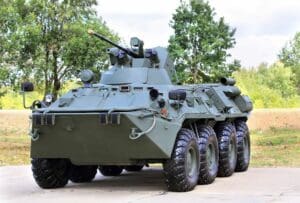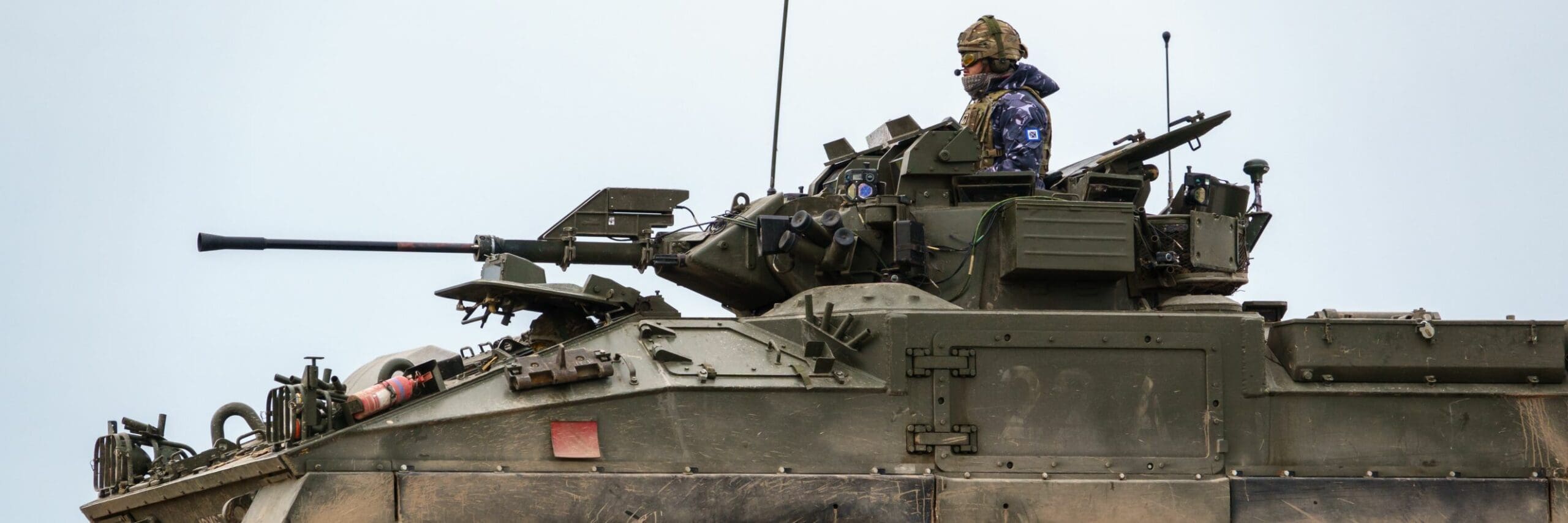Armored vehicles, integral to modern warfare and security operations, are heavily protected transportation designed to shield soldiers and weaponry from enemy fire. These vehicles range from large, heavily armored tanks to lighter, more agile military vehicles used for various purposes, including transport, reconnaissance, and direct combat. As the world of defense evolves, so does the technology and the strategy behind these critical assets. Join Maris-Tech, experts in Edge AI computing solutions, as we examine military vehicles forecasts, trends, and technologies.
Armored Vehicles Market Growth and Forecast
The armored vehicles market size is experiencing robust growth, with its value projected to reach $35 billion by 2032, growing at a compound annual growth rate (CAGR) of around 5% from 2023. North America, particularly the United States, has dominated the armored vehicles market due to its high military budget and ongoing modernization programs. Meanwhile, the Asia Pacific region is expected to register the highest military vehicle growth, driven by increasing military budgets in countries like India, South Korea, and China.
Future Military Vehicle Technology
The armored vehicles sector is undergoing a significant transformation, driven by a range of technological advancements that are redefining their capabilities and applications. Here are some key future military vehicle technologies and their impact on the armored vehicles market, highlighting how they contribute to the changing landscape of military operations and defense capabilities.
Active Protection Systems for Future War Vehicles
Active protection systems (APS), which combine sensors, radar, weapons, and countermeasures have evolved significantly, marking a major shift from passive armor protection to active defense in military armored vehicles. APS is increasingly being used on main battle tanks (MBTs) and is expected to expand to other types of military vehicles in the future, enhancing force protection and survivability on the battlefield. These systems detect and neutralize incoming threats, providing an additional layer of defense beyond the vehicle’s armor.
Enhancing Armored Vehicle Survivability
The survivability of armored vehicles is a key focus area, with developments in materials and technologies that enhance the vehicles’ ability to withstand attacks.
Included in the military vehicles’ forecast are not only advanced armor materials but also systems that can detect and respond to threats, further ensuring the safety of the occupants.
Electric and Hybrid Drivetrains in Future Military Vehicle Technology
The integration of electric and hybrid drivetrains is a significant trend. These drivetrains offer operational advantages such as quieter movement for stealth operations, better torque control, and reduced maintenance costs. The U.S. Army,
for example, is focusing on transforming its ground vehicle fleet with these technologies.
Unmanned Combat Ground Vehicles
There’s a rising trend in the adoption of unmanned combat ground vehicles (UCGVs), driven by their capability to perform intelligence, surveillance, and reconnaissance (ISR) and combat operations without risking human lives.
Modular Ballistic Armor Systems
Modular ballistic armor systems provide flexibility in configuring the armor based on specific threats and mission requirements, enhancing the adaptability of armored vehicles.
Military Vehicles Future: Situational Awareness and Communication Systems
Improvements in situational awareness technologies, including advanced observation and display systems and interoperable communication systems, are essential for modern armored vehicles, enabling crews to stay informed and connected on the battlefield. Maris-Tech recently announced they received a significant order for a customized situational awareness solution for armored and autonomous vehicles. The system, based on the Company’s Jupiter AI platform, will incorporate advanced video streaming and recording, along with AI capabilities, providing critical real-time intelligence.
Armored Vehicles Mobility Trends
Wheeled armored vehicles are gaining prominence due to their improved on-road performance, better fuel economy, and lower maintenance costs compared to tracked vehicles. Electric propulsion, in particular, is expected to be the fastest-growing segment in the market, aligning with global efforts to reduce greenhouse gas emissions and offering operational advantages like stealth and reduced maintenance.

Military Vehicle Forecast on Future Challenges and Opportunities
As the armored vehicles market continues to evolve, it faces a complex array of challenges and opportunities that shape its future direction. While future military vehicle technology offers enhanced capabilities and operational efficiency, it also brings about new challenges in cost, complexity, and security. Simultaneously, global market dynamics present both hurdles and potential growth areas for manufacturers and defense organizations. Understanding these challenges and opportunities is crucial for stakeholders to navigate the armored vehicle market effectively and capitalize on its potential. Here are some of the key issues and prospects facing the armored vehicles industry:
Cybersecurity Threats
With the increasing reliance on advanced technologies, armored vehicles are becoming vulnerable to cyber threats. Ensuring robust cybersecurity measures is crucial to safeguard the integrity and functionality of these vehicles.
Cost and Complexity of Modern Armored Vehicles
The high cost and complexity of modern armored vehicles pose significant challenges. Advanced technologies and specialized materials in the armored vehicles market increase production costs, making procurement and maintenance expensive for defense forces. Balancing budget constraints with the need for advanced capabilities is a key challenge for governments and military organizations.
Environmental and Operational Benefits of Electrification
The shift towards electrification presents opportunities to reduce environmental impacts while improving the operational efficiency and stealth capabilities of armored vehicles.
Emerging Armored Vehicles Market and Export Opportunities
Emerging markets offer significant growth opportunities for armored vehicle manufacturers. Countries modernizing their defense forces are potential customers for advanced armored vehicles, presenting export opportunities for manufacturers in established markets.
Integration of Advanced Technologies
The integration of technologies like autonomous systems, low latency video streaming, improved communication, and situational awareness are essential for addressing modern security challenges and enhancing the versatility of future military vehicles.
A Military Vehicles Forecast: Navigating the Future of Military Vehicle Development
The armored vehicles market is evolving rapidly, driven by technological advancements, changing military needs, and environmental considerations. The integration of electric and hybrid drivetrains, unmanned systems, modular armor, and advanced communication and situational awareness technologies are key trends shaping this sector. With significant growth projected in the coming years, the industry is well-positioned to meet the diverse and complex demands of modern warfare and security operations. Maris-Tech’s recent contribution to the military vehicles forecast through its advanced AI-accelerated video solutions for edge platforms further highlights the innovative and evolving nature of the industry.
Contact Maris Tech to learn more about cutting-edge solutions — transforming possibilities at the forefront of innovation.


